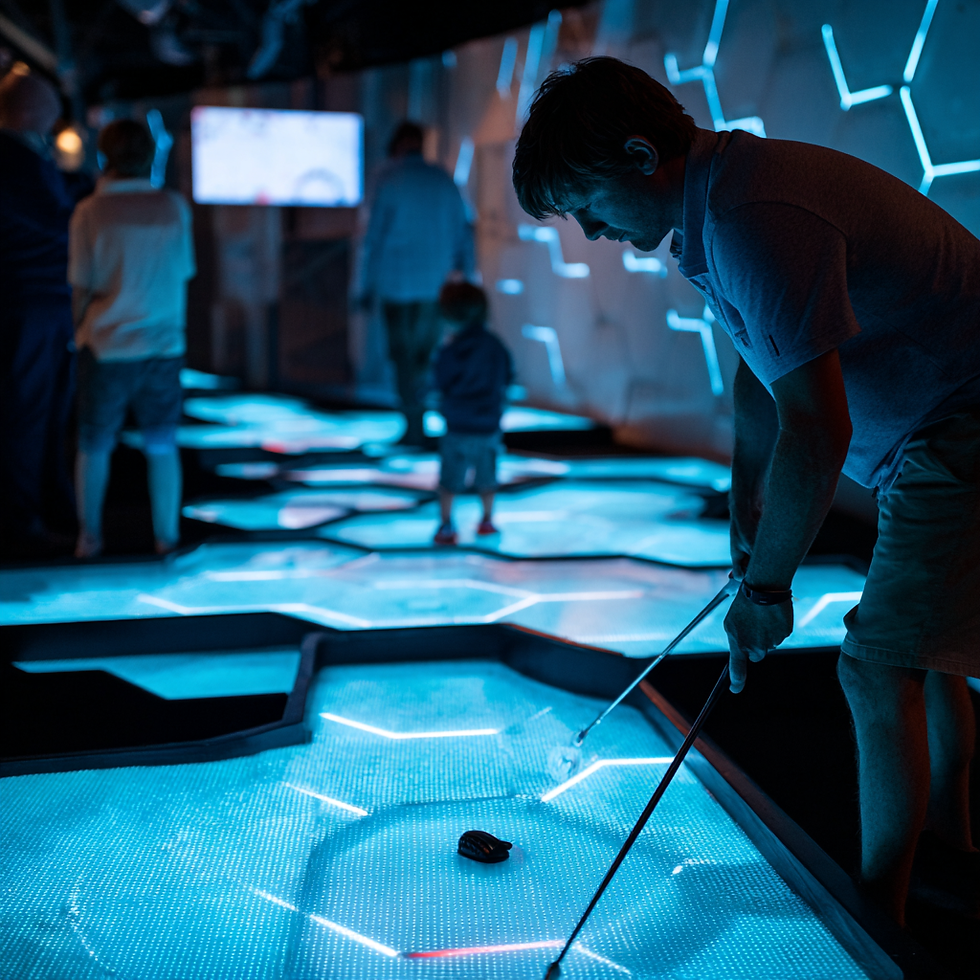Smart Mini-Golf Benefits: 40% More Play Time Boosting Engagement and Revenue
- Christopher R

- Sep 5
- 4 min read
Proof in the Numbers: Why Smart Mini-Golf Delivers 40% More Play Time Than Traditional Courses
Mini-golf, a timeless pastime enjoyed by families, friends, and casual players, has undergone a remarkable transformation in recent years. Modern mini-golf courses, powered by cutting-edge technology and innovative design, are not just about putting a ball through whimsical obstacles; they are becoming immersive, interactive experiences that captivate players and keep them coming back for more. Notably, data indicates that smart mini-golf courses deliver approximately 40% more play time compared to traditional courses; an achievement supported by engagement metrics and increased return on investment (ROI). In this article, we'll explore the numbers, the technology, and the strategies driving this exciting shift in the mini-golf world.

The Rise of Modern Mini Golf: Beyond the Basics
Traditional mini-golf courses have long focused on fun but often feature static obstacles and predictable layouts. This can sometimes result in shorter play sessions and decreased interest, especially among younger, tech-savvy audiences. Modern mini-golf reimagines the experience by integrating digital elements such as dynamic lighting, interactive sensors, real-time scoring, and occasionally augmented reality (AR). Such innovations create immersive environments that respond to players' actions, offering fresh challenges and renewed excitement with each visit.
Additionally, modern courses often feature themed designs, storytelling, and multiplayer connectivity to encourage social interaction and friendly competition. These additions are not merely aesthetic; they are informed by data-driven design aimed at boosting engagement and extending play time.
How Smart Mini-Golf Boosts Engagement Metrics
The most persuasive evidence for smart mini-golf’s enhanced engagement comes from precise player data collection. Unlike traditional courses, where insights often rely on anecdotal evidence, smart mini-golf facilities utilize advanced tracking technologies to gather detailed information on session duration, visit frequency, and player interaction levels.
Available data shows that smart mini-golf players spend about 40% more time on the course than those at conventional venues. Key contributing factors include:
Interactive Features Sustain Attention: Digital scoreboards and varied game modes keep players engaged. Gamification elements like challenges, levels, and rewards maintain novelty and motivate longer play sessions.
Personalized Gameplay Enhances Retention: Data collection allows courses to tailor difficulty levels and provide hints suited to individual skill sets, ensuring gameplay remains challenging yet enjoyable.
Social Connectivity Encourages Repeat Visits: Integration with mobile apps and social media platforms enables remote competitions and sharing of achievements, deepening social engagement and fostering community.
Such robust data not only confirms increased play time but also helps operators refine their offerings based on player preferences.
ROI: The Business Case for Smart Mini-Golf Investment
Operators adopting modern, data-driven mini-golf solutions report significant returns. The observed 40% increase in play time translates directly into higher revenue per guest. Longer sessions encourage spending on concessions, merchandise, and premium options such as food packages or memberships.
Higher engagement also fosters greater customer retention, leading to new visitors through word-of-mouth and reducing marketing costs. Moreover, data analytics enhance operational efficiency by informing staffing, maintenance scheduling, and targeted promotions. When forecasting busy periods and customizing pricing or advertising, operators can maximize profitability.
Reports indicate that several venues have experienced up to a 30% revenue increase within the first year of implementing digital mini-golf platforms, reflecting extended play and improved customer experience.
Key Features Driving the Success of Smart Mini-Golf
Understanding why smart mini-golf yields higher engagement involves highlighting features typically found in these modern courses:
Real-Time Tracking and ScoringSensors embedded in obstacles and smart putters capture stroke data precisely, feeding digital leaderboards both on-site and in companion apps to encourage friendly competition.
Adaptive Difficulty LevelsPlayer performance data allows courses to modify challenges and provide personalized hints, maintaining engagement for a wide range of skill levels.
Immersive Visual and Audio EffectsDynamic lighting, soundscapes, and projection mapping create captivating atmospheres that refresh sensory stimuli and sustain player interest over time.
Gamification ElementsAchievements, daily challenges, and tournaments transform mini-golf into an ongoing interactive game, fostering player loyalty and repeat visits.
Social and Mobile IntegrationLinking play data with social media and mobile apps enhances community building, supports remote play, and enables sharing of highlights to deepen player investment.
Data-Driven Operational OptimizationOperators monitor peak usage, identify bottlenecks, and use predictive analytics to improve customer flow and maximize course capacity efficiently.
Practical Takeaways for Mini-Golf Operators and Enthusiasts
Whether you manage a mini-golf course or enjoy the game as a player, consider these insights from the smart mini-golf trend:
Adopt Technology to Increase Play Time: Smart features have proven to improve player engagement and overall enjoyment significantly.
Use Data to Customize Gameplay: Tailor challenges based on player tendencies to keep both novices and experts equally motivated throughout their session.
Cultivate Social Experience: Enable platforms for competition and sharing to transform casual visits into group events that encourage repeat visits.
Track Metrics for Continuous Growth: Utilize playtime and score data, along with customer feedback, to evolve course design and marketing strategies effectively.
Expand Revenue through Extended Play: Longer sessions often drive higher spending on merchandise, concessions, and premium offerings, enhancing profitability.
Stay Current with Industry Trends: Emerging technologies such as AR, smart lighting, and enhanced mobile integration will continue to shape the future of mini-golf.
Wrapping Up: Why Smart Mini-Golf Is the Future
Mini-golf is evolving into a sophisticated entertainment experience through smart, data-driven innovations. Evidence shows that players at modern courses enjoy about 40% more play time, reflecting deeper engagement and overall satisfaction. This increase benefits operators with improved ROI, making smart mini-golf a mutually advantageous advancement.
As technology and data analytics continue to evolve, mini-golf is shifting from a simple recreational activity to a vibrant, interactive adventure. Both course owners and players stand to gain from this exciting future of increased fun, connection, and repeat play.
For those interested in a deeper exploration, innovations such as intelligent lighting systems, mobile app integration, and comprehensive analytics tools will keep enhancing the mini-golf experience. Investing in these technologies ensures your course remains competitive.



Comments